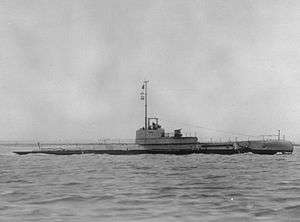HMS Sturgeon (73S)
 HMS Sturgeon | |
| History | |
|---|---|
| Name: | HMS Sturgeon |
| Builder: | Chatham Dockyard |
| Laid down: | 1 January 1931 |
| Launched: | 8 January 1932 |
| Commissioned: | 15 December 1932 |
| Recommissioned: | 17 November 1945 |
| Renamed: | to Dutch Navy as Zeehond, 11 October 1943 |
| Fate: | broken up January 1946 |
| Name: | HNMS Zeehond |
| Commissioned: | 11 October 1943 |
| Decommissioned: | 14 September 1945 |
| Fate: | returned to Royal Navy 17 November 1945 |
| General characteristics | |
| Displacement: |
|
| Length: | 202 ft 6 in (61.72 m) |
| Beam: | 24 ft (7.3 m) |
| Draught: | 10 ft 6 in (3.20 m) |
| Propulsion: | Twin diesel/electric |
| Speed: |
|
| Complement: | 36 officers and men |
| Armament: |
|

HMS Sturgeon was a British S class submarine built by HM Dockyard, Chatham. She was laid down on 1 January 1931 and was commissioned on 15 December 1932. She was one of the four submarines that formed the First Group of the S class, and the only one of these to survive the war.
Career
Sturgeon spent most of her career in the North Sea, off the Scandinavian coast. On September 14, 1939, she attacked her sister ship HMS Swordfish with three torpedoes but they all missed. This took place off the coast of Norway. Because of this incident, the Admiralty increased the operating distance of British submarines off Norway from 4 miles to 16 miles. She also attacked the German submarine U-23, but failed to hit her. Sturgeon claimed her first success when she sank the German anti submarine trawler V-209 (formerly Gauleiter Telshow) on 20 November 1939. The sinking of the V-209 was the first successful attack on an enemy ship by a British submarine during the Second World War.[1]
She went on to sink the German troop transport Pionier, the Danish merchant Sigrun, the Norwegian merchant Delfinus, and the German merchant Boltenhagen. She also fired six torpedoes against the German submarine U-43, but they all missed their target.[2]
She was one of a number of submarines ordered to track the German battleship Bismarck before her eventual sinking.
HMS Sturgeon was then lent to the Royal Netherlands Navy from 11 October 1943 to 14 September 1945. During this time, she was renamed Zeehond.[3]
HMS Sturgeon was returned to the Royal Navy after being lent to the Royal Netherlands Navy, and then broken up at Granton in January 1946.
Notes
- ↑ Don Kindell (17 September 2008). "Naval Events, November 1939, Part 2 of 2". Naval-History.Net. Retrieved 12 December 2010.
- ↑ HMS Sturgeon, Uboat.net
- ↑ HNMS Zeehond, Uboat.net
References
- Submarines, War Beneath The Waves, From 1776 To The Present Day, by Robert Hutchinson.
- Colledge, J. J.; Warlow, Ben (2006) [1969]. Ships of the Royal Navy: The Complete Record of all Fighting Ships of the Royal Navy (Rev. ed.). London: Chatham Publishing. ISBN 978-1-86176-281-8. OCLC 67375475.
External links
| ||||||||||||||||||||||||||||||||||||